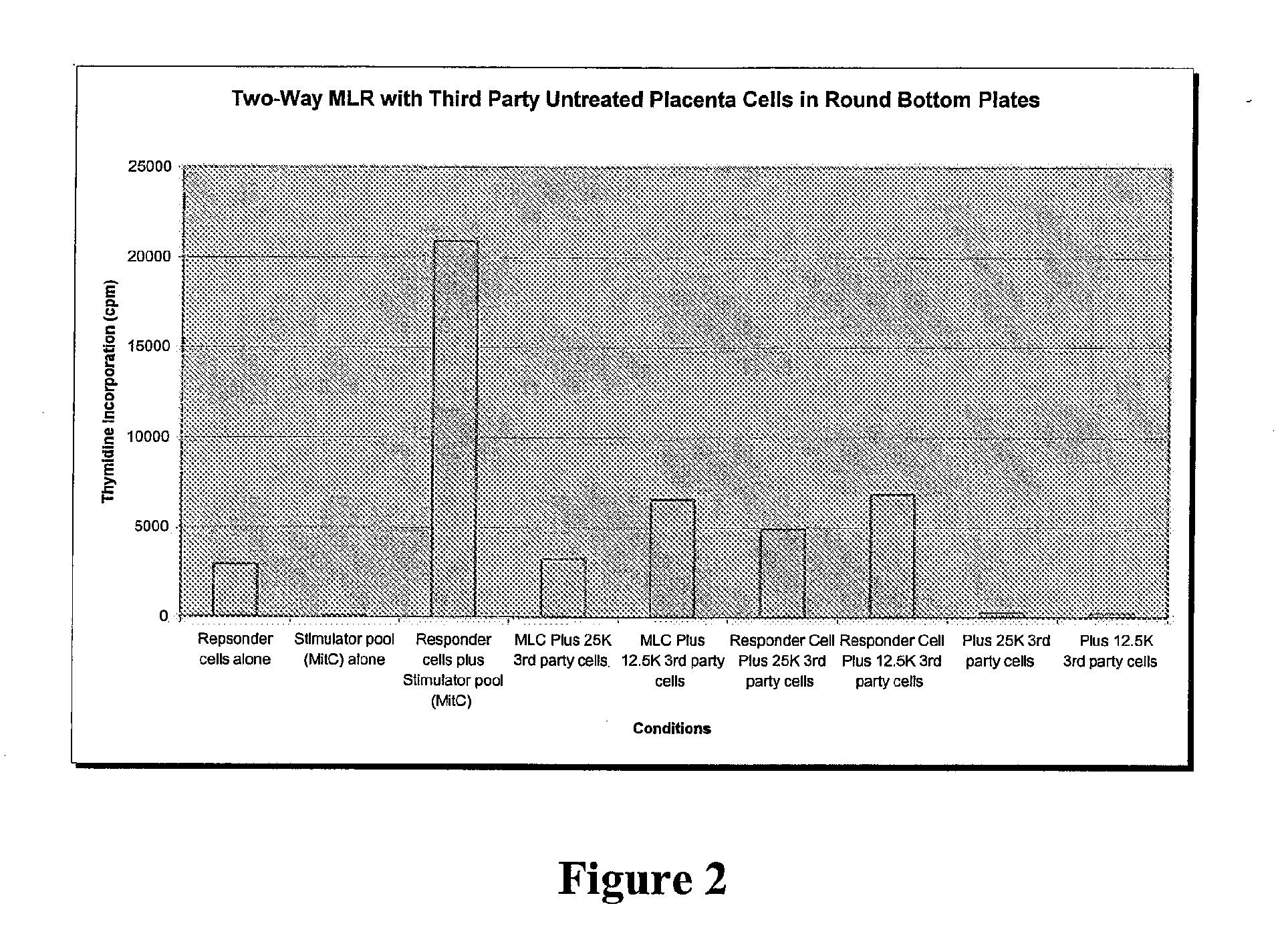Compositions and methods for inhibiting adverse immune response in histocompatibility-mismatched transplantation
a technology of immune response and histocompatibility, applied in the field of immunology of transplantation, can solve the problems of graft versus host disease, high variability of hla expression, and bmt and hsct, and achieve the effect of inhibiting the adverse immune respons
- Summary
- Abstract
- Description
- Claims
- Application Information
AI Technical Summary
Benefits of technology
Problems solved by technology
Method used
Image
Examples
example 1
Derivation of Cells from Postpartum Tissue
[0131] This example describes the preparation of postpartum-derived cells from placental and umbilical cord tissues. Postpartum umbilical cords and placentae were obtained upon birth of either a full term or pre-term pregnancy. Cells were harvested from 5 separate donors of umbilicus and placental tissue. Different methods of cell isolation were tested for their ability to yield cells with: 1) the potential to differentiate into cells with different phenotypes, a characteristic common to stem cells, or 2) the potential to provide trophic factors useful for other cells and tissues.
Methods & Materials
[0132] Umbilical cell isolation. Umbilical cords were obtained from National Disease Research Interchange (NDRI, Philadelphia, Pa.). The tissues were obtained following normal deliveries. The cell isolation protocol was performed aseptically in a laminar flow hood. To remove blood and debris, the cord washed in phosphate buffered saline (PBS; ...
example 2
REFERENCES FOR EXAMPLE 2
[0171] 1) Hayflick L. 1974a. J Am Geriatr Soc. 22:1-12. [0172] 2) Hayflick L. 1974b. Gerontologist. 14:37-45. [0173] 3) U.S. Patent publication US20040058412 [0174] 4) U.S. Patent publication US20040048372 [0175] 5) U.S. Patent publication US20040005704.
example 3
Evaluation of Growth Media for Placenta-Derived Cells
[0176] Several cell culture media were evaluated for their ability to support the growth of placenta-derived cells. The growth of placenta-derived cells in normal (20%) and low (5%) oxygen was assessed after 3 days using the MTS calorimetric assay.
Methods & Materials
[0177] Placenta-derived cells at passage 8 (P8) were seeded at 1×103 cells / well in 96 well plates in Growth Medium with penicillin / streptomycin. After 8 hours the medium was changed as described below and cells were incubated in normal (atmospheric) or low (5%, v / v) oxygen at 37° C., 5% CO2 for 48 hours. MTS was added to the culture medium (CELLTITER 96 AQueous One Solution Cell Proliferation Assay, Promega, Madison, Wis.) for 3 hours and the absorbance measured at 490 nanometers (Molecular Devices, Sunnyvale Calif.).
TABLE 3-1Culture MediaAdded fetalbovineCulture MediumSupplierserum % (v / v)DMEM low glucoseGibco Carlsbad CA0, 2 10DMEM high glucoseGibco0, 2 10RPMI ...
PUM
| Property | Measurement | Unit |
|---|---|---|
| Fraction | aaaaa | aaaaa |
| Fraction | aaaaa | aaaaa |
| Fraction | aaaaa | aaaaa |
Abstract
Description
Claims
Application Information
 Login to View More
Login to View More - R&D
- Intellectual Property
- Life Sciences
- Materials
- Tech Scout
- Unparalleled Data Quality
- Higher Quality Content
- 60% Fewer Hallucinations
Browse by: Latest US Patents, China's latest patents, Technical Efficacy Thesaurus, Application Domain, Technology Topic, Popular Technical Reports.
© 2025 PatSnap. All rights reserved.Legal|Privacy policy|Modern Slavery Act Transparency Statement|Sitemap|About US| Contact US: help@patsnap.com



